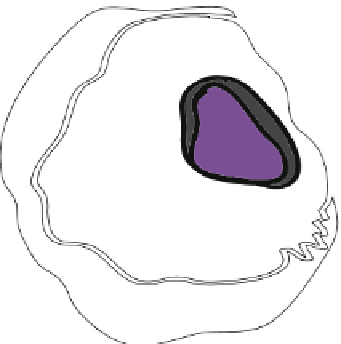Biology Reference
In-Depth Information
Chromosomes in the cell's
nucleus are the source of
nuclear DNA (nDNA)
Mitochondria in the cell's
cytoplasm are the source of
mitochondrial DNA (mtDNA)
FIGURE 16.2
Eukaryotic cell showing locations of nuclear and mitochondrial DNA.
that structure within the cell that houses the bulk of an organism's hereditary information, or
DNA. Mitochondria (singular, mitochondrion), as the “powerhouses” of the cell, are located
within the bounds of the cell membrane in the thick liquid called cytoplasm, but outside of
the nucleus. DNA housed in the nucleus is called nuclear DNA, or
nDNA
, while DNA
housed in mitochondria is called mitochondrial DNA, or
mtDNA
.
In humans, nuclear DNA is packaged into 23 pairs of
chromosomes
, including a pair of
sex chromosomes. Nuclear DNA is, for the most part, biparentally inherited: each of your
biological parents contributed approximately half of your DNA. The only exception to this
is a significant portion of the male sex chromosome, the Y chromosome. Over 95% of the Y
chromosome is inherited relatively intact from the biological father and is referred to as
the
NRY
,or
N
on
R
ecombining
Y
(also
MSY
,or
M
ale-
S
pecific
Y
) (
Figure 16.3
).
Mitochondrial DNA is inherited exclusively from the mother; males do not contribute
mitochondria to offspring. A female's reproductive cell, the ovum (egg), contains within it
a set of 23 chromosomes in a nucleus, plus copies of maternal mitochondria. Though the
male reproductive cell, or sperm, does have mitochondria (mostly wrapped around the
tail to power its movement), its mitochondria fail to enter and are quickly degraded upon
contact with the egg.
In sum, while most nuclear DNA is biparentally inherited, the NRY and mtDNA are
uniparentally inherited. Only sons inherit the NRY from their fathers, but both sons and















































































































